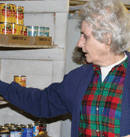See how God's love shows us the way of life. Rule of Benedict
A tall, soft-spoken man shuffles down the stairs to the cold concrete basement of Sacred Heart Catholic Church in Rock Island. He is dressed in blue hospital scrubs and a black warm-up jacket. He pulls the bill of his black baseball cap further down over his eyes and jams his hand back into his pocket.
"How many in your family?" asks Mike, a volunteer at the oldest food pantry in the Quad Cities. "Four," he answers. Mike directs him to Benedictine Sr. Margaret Suerth, OSB, who waits at the first stop along the pantry route. She fills his bag with peanut butter, jelly, grape juice, black beans and chicken noodle soup. You can barely hear his whispered "Thanks." Across the room, Benedictine Sr. Anne Newcomer, OSB, fills more bags with two chickens, two boxes of instant mashed potatoes, a package of toilet paper, three boxes of macaroni and cheese and a super-sized box of Froot Loops.
The place looks more like a play store or a camp kitchen than a grocery distribution site. Cans, boxes and bags of food line the dusty wood shelves. Packing boxes piled to the ceiling teeter in the corners. Paper bags stuffed with crusty loaves of bakery bread fill the table next to the door. Frozen chickens fill the upright freezer. An assortment of household and toiletry items – from sandwich bags to hotel-sized shampoos – fill another table.
"I always think if we can give them cereal and chicken, they get what they need," Sr. Anne says as the first customer disappears back up the steps.
"It feels good to give them the kinds of things they can build a meal around," Sr. Margaret agrees. "Meat, mashed potatoes. Peanut butter and jelly, especially for the kids. The customers are always more concerned about the kids than they are about themselves."
The next customer files in. The tiny room won't hold more than a handful of people at once, so they line up in the hallway outside. It's impossible to guess this woman's age, although her waist-length, honey-colored hair might help her pass for a teenager from behind. She has five in her family. She smiles out from under her hair at Sr. Margaret. Yes, she would like peanut butter and jelly. Her hands are in her pockets. The customers all keep their hands in their pockets.
"There are a lot of people who don't have enough to eat," Sr. Margaret says. "Some have lost their jobs. Some are living in their cars. There are lots of grandmothers taking care of grandchildren."
The next customer is tall and stately, with her long hair styled in corn rows and twisted into a chignon. Her eyebrow is studded with a silver dumbbell. Her men's flannel shirt hangs like a dress, and her men's khaki pants bag around her ankles. Her answers are tight and clipped, "Yes, yes, um hmm." She steps back to allow Sr. Margaret to pick up a box that falls at her feet.
"Everyone who comes here is hungry," Sr. Margaret says when asked - after the customer leaves - how she feels about such a show of seeming ingratitude. "Everyone is suffering."
Mike has a harder time with it. "Sometimes the customers smell bad. Sometimes they smell like alcohol. It's hard to see Jesus in everyone. But the Sisters help me be generous."
Sr. Anne says volunteering here changes them. "We are better people because we come here. You can read about poverty in the paper, but until you meet people struggling with it you don't understand. You find out they're just like you. I pray, Oh, help them, Lord."
Now a beautiful woman with a faux-fur trimmed black cape is shopping for eight, while the next customer, a genial fellow who has lost a few teeth, is shopping for three. His bulky black coat hangs halfway down his legs, and his pants bunch up at the ankles. He props a cereal box on his shoulder to shield his face.
"We're always out of fresh stuff," Sr. Anne says. "We run out of canned fruit right away, too. And tuna. We get food from the government and from donations. The Sisters of St. Benedict support us. Parishioners donate their old grocery bags, and cans of food, too."
"Somebody gave $2,000 anonymously one time," Sr. Margaret says. "I had to call and ask if it was right. We never received that kind of money before."
The morning is almost over. The final customer appears. She sports an I Dream of Jeanie hairdo, a quilted black jacket and brown velour pants. She wraps and rewraps a scarf around her face. She, like most customers, is embarrassed to be here. Hands stuffed in pockets, voices not often above a whisper, they want to run away. But hunger is a strong motivator, especially when the hunger belongs to the children in their care. So they stay for the food. And when Srs. Anne and Margaret are here, they get something more: a prayer for better days.
